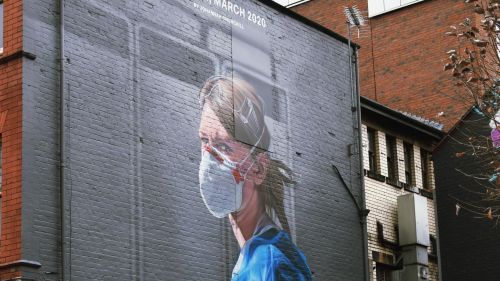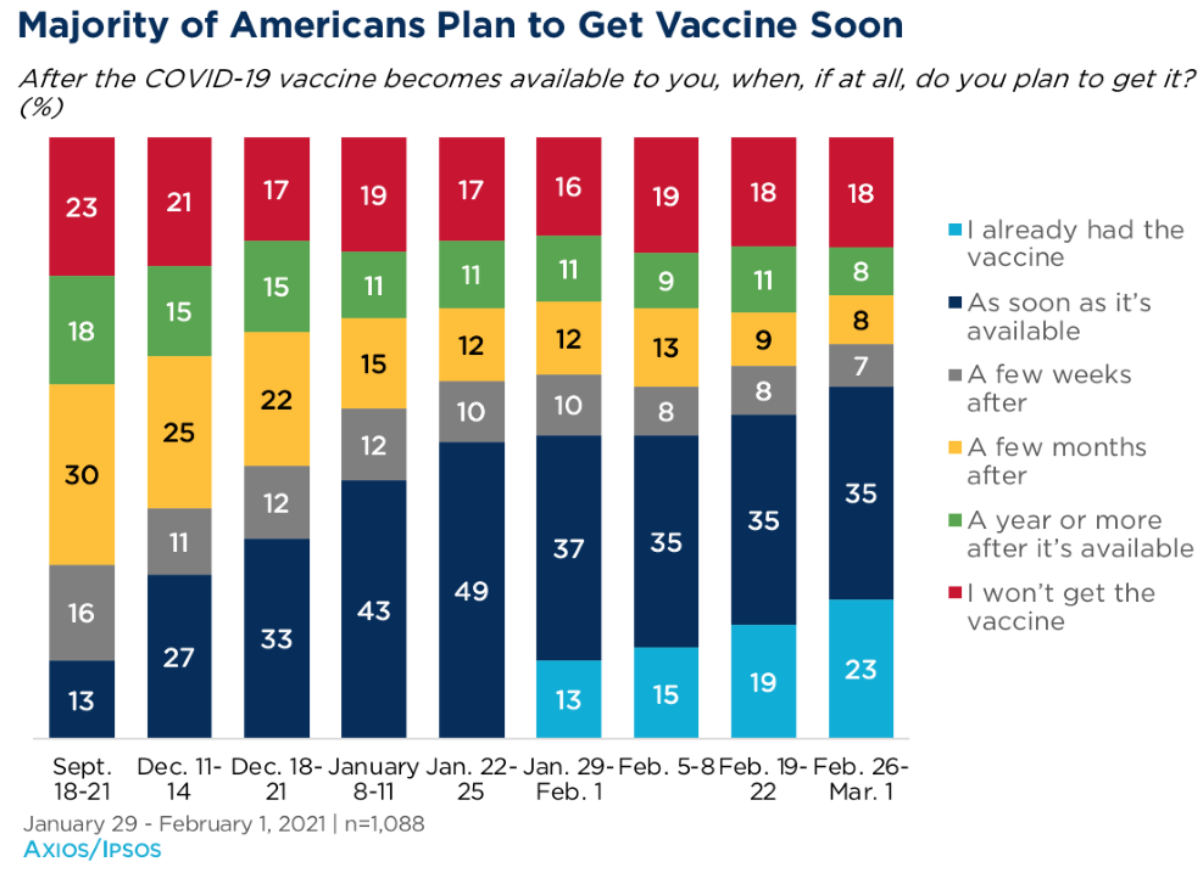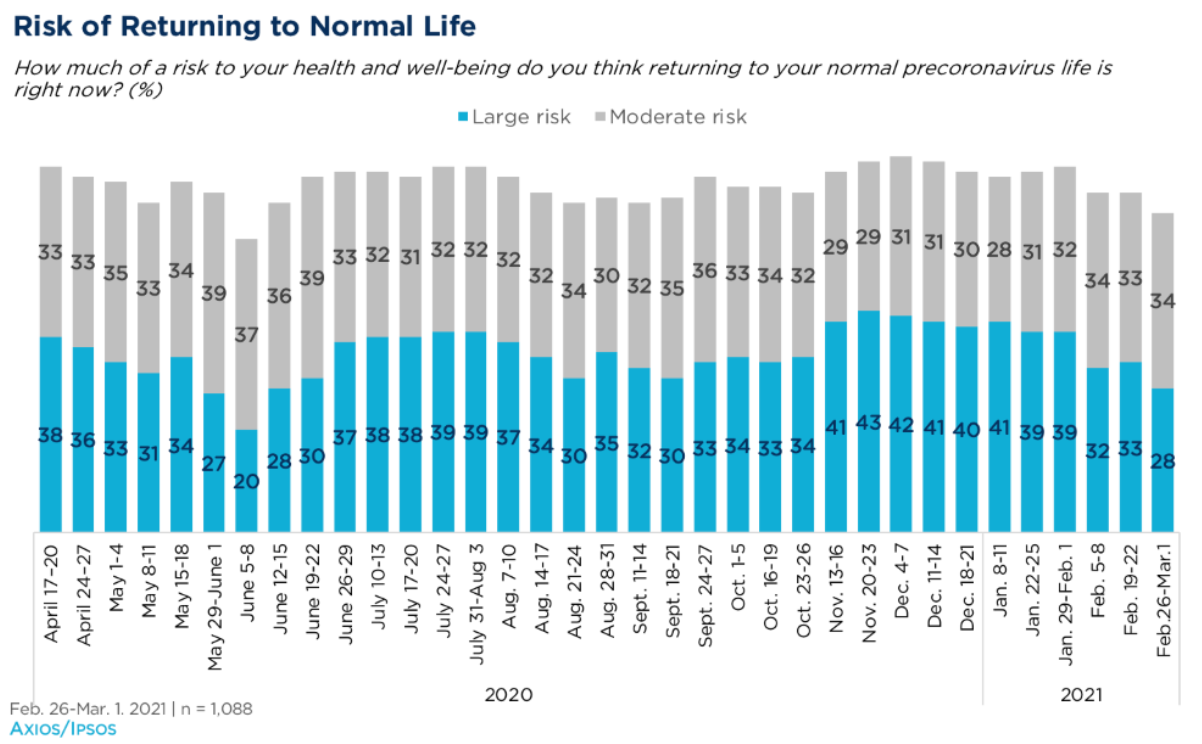After a Year of Pandemic, Global Public Opinion Shows Increasing Desire for Vaccine

It has now been a year since many nations began to implement restrictions due to the pandemic. As the global health crisis drags into its second year, more people seek the vaccine as a way to return to normal.
This week the world passed the 114.7 million case mark, with over 2.5 million deaths attributed to COVID-19. One year into the pandemic, the situation appears to be slowly improving as cases decline. However, with lockdown fatigue plaguing people around the world, it may be too soon to return to normal.
For this week’s COVID-19 update, the Chicago Council Survey team looks at polling results from the United States, Japan, South Korea, France, the United Kingdom, India, and China.
Key Findings
- Most Americans (65%) say they expect to be able to return to their normal, pre-COVID lives within the next year.
- Three in ten Japanese (31%) say they want to receive a vaccine immediately, while a majority (57%) plan to first assess what kind of side effects there are before seeking vaccination.
- Six in ten French people (61%) now intend to get the vaccine, but not due to government actions. Regarding the vaccine rollout in France, two-thirds (68%) say that the Élysée has not inspired confidence.
- Although it remains a controversial idea, six in ten (60%) Britons support the introduction of a vaccine passport.
- While 72 percent of South Koreans intend to get the vaccine, they are more likely to trust the Pfizer (62%) and Moderna (53%) vaccines, than the AstraZeneca vaccine (44%).
- Data from China shows that 80 percent of Chinese people intend to take the vaccine, the highest vaccination intent among 15 countries included in a recent Ipsos survey.
- As a strong majority of Indians (85%) feel optimism about the trajectory of the pandemic at home, a plurality (43%) say they are primarily concerned about unemployment in India.
The United States
28.7 million cases, 515,710 deaths
Vaccine rollout continues across the United States. Due to the newly approved third vaccine produced by Johnson & Johnson, millions of additional doses are expected to reach Americans’ waiting arms this month.
Axios-Ipsos polling conducted February 26-March 1 finds that most Americans (80%) know at least one other person, and in some cases more than one other person, who has already been vaccinated, including themselves (23%), a member of their immediate family (37%), or someone else (47%). And rising numbers of Americans say they are either likely to get—or have already gotten—a COVID-19 vaccine as soon as it’s available. Just under half of Americans (46%) say they are very or somewhat likely to get a vaccine, with another 23 percent saying they have already gotten one. The same poll also shows that fewer Americans are planning to wait a while to get a vaccine after it becomes available, compared to late December, when the first vaccines were released for healthcare workers.

Of course, as the Wall Street Journal noted last week, the phrasing of questions about whether or not Americans intend to get vaccinated matters greatly, and other polls find varying levels of enthusiasm about vaccination. For example, CBS/YouGov polling finds that half of Americans will get (or have already gotten) a coronavirus vaccine when it becomes available to them. Another quarter (24%) say they might get one and a final quarter (25%) say they will not. Among that half of Americans who are not seeking a vaccine, top reasons for vaccine hesitancy include wanting to wait and see what happens with the vaccine (58%) and concerns about allergies or side effects (46%).
Axios-Ipsos polling also finds that Americans are starting to see the light at the end of the tunnel: most (65%) say they expect to be able to return to their normal, pre-COVID lives within the next year and a third (33%) expect to do so within the next six months.
Some of that desire for a return to normal life is also showing up in self-reported behaviors. For example, the proportion of Americans who say they have social-distanced in the last week has declined somewhat over the past month, from 79 percent in a February 5-8 poll down to 71 percent in the latest February 26-March 1 poll.
One behavior that hasn’t changed much in the last six months: working from home. More than a third of Americans (36%) report working remotely instead of from their normal workplace, as they have since the summer.
That doesn’t mean Americans are simply fed up with restrictions and feel like taking some risks. Only a third of Americans say they are willing to accept a large (10%) or moderate risk (23%) to the health and well-being of themselves and their family, a proportion that has held steady since May 2020. Instead, changing behaviors reflect changing perceptions of risk. Americans today see a return to normal as less risky than before, with decreasing proportions seeing it as a large (28%) or moderate (34%) risk. This is the lowest perceived risk since early June 2020, following the first wave of the pandemic and prior to the beginning of the second wave in the summer.

Japan
432,797 cases, 7,989 deaths
Japan’s vaccination campaign, though latest to start among the G7 nations, is underway. Japan is starting with an initial target group of 40,000 healthcare workers and plans to follow up with a broader set of 4.7 million medical workers this month.
With the rollout underway, Nikkei polling conducted February 27-28 finds a fairly supportive public response. In contrast to a still negative evaluation of the government’s handling of the pandemic (50% disapprove, 43% approve), the public views the government’s vaccine efforts favorably (56%, vs. 34% disapproval). Around three in ten Japanese (31%) say they want to receive a vaccine immediately, while a majority (57%) plan to first assess what kind of side effects there are before seeking vaccination. Relatively few (9%) are outright opposed to getting vaccinated.
The next key population for vaccination in Japan will be the 36 million Japanese over the age of 65. A vaccination campaign targeting these older Japanese is set to launch on April 12 with an initial shipment of 250,000 doses nationwide. But a recent survey conducted by Tokyo-based health care service provider Internet Infinity reveals there is still work to do in persuading this at-risk population. Conducted among a population of 423 elderly Japanese who require home nursing care, four in ten (43%) said they were unsure about receiving vaccinations and another 15 percent opposed getting a vaccine. Their concerns focused on the safety of vaccines and potential side effects (77%), as well as the effectiveness of the vaccine (39%). But the poll also points to potential solutions: four in ten (44%) said that an increase in vaccination numbers nationwide might be a deciding factor in getting vaccinated, as could the vaccination of family or friends (39%) or requests from their families (27%).
As vaccines roll out across the country, Japan is also emerging from its second state of emergency as cases decline nationwide. Reflecting the improving coronavirus situation, the state of emergency in six prefectures (Aichi, Gifu, Osaka, Kyoto, Hyogo, and Fukuoka) was lifted a week earlier than the planned March 7 expiration. However, restrictions will remain in place. The prefectures will continue to request that restaurants and bars close early, though at 9 p.m. rather than the 8 p.m. closures under the state of emergency. The state of emergency remains in place in Tokyo and three neighboring prefectures of Chiba, Kanagawa, and Saitama, and the governors of these prefectures are seeking an extension of the emergency from Prime Minister Suga. In Nikkei polling, many Japanese (57%) say the state of emergency should be extended in some areas and a quarter (26%) say it should be extended in all areas currently subject to a state of emergency. That may reflect concerns about a resurgence of infections should restrictions lift too soon, especially before widespread vaccination can provide a sufficient barrier to COVID-19’s spread.
South Korea
90,816 cases, 1,612 deaths
As of March 1, South Korea reported 338 new cases and 1,605 total deaths. Vaccine distribution is now underway and South Korea hopes to achieve 70 percent herd immunity by November. However, doubts remain about the feasibility of this goal.
Getting vaccines into arms should be less challenging in South Korea than in some other countries. Not only will distribution be centralized through the national government, but 72 percent of the South Korean public says they will get the vaccine according to a Gallup Korea survey fielded February 23-25. But there is some variation among age groups. Among those in their 30s, 59 percent say they will get the vaccine. For those in their 20s, 60 percent say the same. While still a majority for both age cohorts, that is significantly lower than the roughly 75 percent of all other age groups that say they will get the vaccine.
Vaccine distribution began on February 25 with AstraZeneca distributing doses to nursing home workers and facility patients, and Pfizer and BioNTech distributing vaccines to healthcare workers. In March, AstraZeneca will distribute 350,000 vaccines to high-risk health care workers and 78,000 to first responders.
But there are variations in public trust of different vaccines. While 62 percent say they trust the Pfizer vaccine and 53 percent state trust in the Moderna version, just 44 percent state trust in the AstraZeneca vaccine. The lack of trust in the AstraZeneca vaccine—the first to become available in South Korea—has created a mini political drama. Doubts about its safety have led members of the conservative People Power’s Party to call for President Moon—the leader of the progressive party—to be the first to receive the vaccine to allay public fears. President Moon has refused, saying that he did not want to be seen jumping the cue. And in deeply polarized South Korea, this political fight has led to an unusual rally-around-the-vaccine effect. Among progressives, trust in the AstraZeneca vaccine is 60 percent while it is just 39 percent among conservatives.
Despite hopes for a return to near normal, the South Korean government will continue to enforce social distancing measures. The Health Ministry said that social distancing procedures will stay in place for two more weeks. Social distancing closes cafes, restaurants, and gyms at 10 p.m. and limits occupancy in religious services and sporting events.
China
101,204 cases, 4,636 deaths
Although China has done well in containing COVID-19 through various quarantine measures, it still faces the challenge of vaccinating its 1.4 billion population. This will be a test not only for the country’s ability to mobilize resources, but also for its manufacturing capacity and healthcare system.
A survey conducted by IPSOS from December 17-20 on vaccination intent across 15 countries shows that a majority (80%) of Chinese respondents say they would get a COVID-19 vaccine if it were available, making it the highest percentage across all countries. At the same time, among those who do not wish to take a vaccine, China has the highest proportion (32%) of those who say they are not enough at risk from COVID-19. Citing this statistic, an op-ed in The New York Times argues that China’s success in controlling COVID-19 might lead to a sense of security that will hamper the vaccination process.
Indeed, although China has been actively exporting its vaccines to the developing world, it appears to be lagging behind on vaccinating its own people. According to the National Health Commission of China, 40.5 million doses of vaccine had been administered b as of February 10, falling short of the country’s target to vaccinate 50 million people by Lunar New Year’s Eve, on February 11. According to anonymous sources cited by Bloomberg, however, the goal of vaccinating 50 million Chinese citizens has been pushed back by almost two months to the end of March.
The Economist Intelligence Unit estimated last month that China might not reach 60% vaccine coverage until late 2022, compared with front runners in the vaccination race that are expected to reach that level by late 2021. To win the “second half” of its battle against COVID-19, China will need to confront the logistical challenge of vaccinating its 1.4 billion people.
France
3.7 million cases, 86,454 deaths
As cases continue to creep upward in France, the public’s focus on the pandemic may be diverted by the sentencing of former President Nicolas Sarkozy to three years in prison for corruption and bribery. Though he is likely to be under house arrest for just one year of his sentence, he has expressed his intention to appeal the ruling. Moreover, Sarkozy’s sentencing has generated criticism from conservative French groups, saying that the punishment is disproportionate to the crime.
At the same time, President Emmanuel Macron has asked the French people to hold on for four to six weeks before expecting any loosening of the increased restrictions, including the 6 p.m. to 6 a.m. curfew. However, the French people continue to have a negative view of how Macron and his government have handled the crisis, according to an Elabe poll of 1,002 French people conducted from February 23-24. Asked whether they agree that Macron has made good decisions regarding the health plan in the country, just 43 percent agree while 57 percent disagree. And, on whether he has been up to the job since the beginning of the pandemic, even fewer agree (40%) while six in ten (59%) disagree.
Moreover, the vaccine situation in France continues to evolve. This week, the High Authority of Health (HAS) in France announced that it would update its opinion on the AstraZeneca vaccine for those over the age of 65, indicating that elderly French people may soon have another option to be vaccinated. And, according to a February 17-18 Odoxa poll of 1,005 French adults, more French people say they intend to get vaccinated (61%) than said so in November (50%). In addition, 77 percent of French people aged 65 and older intend to get the vaccine; with such a high rate of intention, the reevaluation of the AstraZeneca vaccine may prove instrumental to vaccinating older French people.
While the intention to be vaccinated has risen, it does not appear to be due to the government’s actions. Concerning the vaccine rollout, majorities of French people say that the actions of the government do not inspire confidence (68%), are not coherent (71%), are not effective (72%), are not clear (74%), and are not happening at a good pace (79%). Moreover, just one quarter (27%) of the French population believes Macron’s statement that every French adult who wants a vaccine will get one by the end of the summer.
The United Kingdom
4.1 million cases, 123,296 deaths
In the United Kingdom, cases have continued to fall steadily as government restrictions and a robust vaccination campaign take effect. But, as news spreads of a person infected with the Brazil variant who cannot be located, fears of a new wave of cases has risen. Subsequently, Downing Street instituted a hotel quarantine rule on February 15, mandating that those coming to the UK from 33 different countries must pay to quarantine at a hotel for 10 days.
While this new policy has just been implemented, there is also increasing discussion about the prospect of a vaccine passport; a pass that allows those who have been vaccinated to enter venues and events. Though this idea is controversial, six in ten Britons (60%) support the introduction of a vaccine passport, according to a February 17th poll of 2,500 British adults conducted by Redfield and Wilton. Asked about the circumstances for which a vaccine passport may be required, six in ten (62%) support one for all circumstances while 22 percent support them only for international travel. Just 15 percent say that they don’t support them at all.
Beyond these new regulations, Prime Minister Boris Johnson spoke on February 22 about the process of relaxing the restrictions which have aimed to reduce the spread of the virus. Johnson explained that the loosening of rules would happen in four stages and would be based on “the pace of the vaccination program, the effectiveness of the vaccines, the pressure on the NHS, and the risks of any new variants of COVID.” Additionally, he confirmed that schools would reopen on March 8, with biweekly tests and mandatory mask usage to prevent further outbreaks among students.
Though there is some disagreement, about half of all parents (50%) and teachers (49%) support reopening schools on March 8, according to a February 5-9 Redfield and Wilton survey. But, two thirds of parents say that schools should not open before the government’s scheduled reopening date. The willingness of parents and teachers to restart school, even as the pandemic continues, arises from fears that students are lagging behind where they should be. Nearly six in ten teachers (56%) say that their students are behind where they would be otherwise in a normal year. Of those teachers, nearly one quarter (23%) say their students are significantly behind, almost one half (46%) say their students are moderately behind, and three in ten (30%) say their students are only somewhat behind. Four in ten parents (40%) agree that their children are behind where they would be otherwise.
India
11.1 million cases, 157,346 deaths
Although India reported a significant drop in the numbers of COVID-19 cases in recent months, the country experienced a major surge of infections in late February. Populated states such as Maharashtra, Kerala, Karnataka, and Punjab are seeing their cases rise and, because travel restrictions are at the lowest levels since the start of the outbreak, many fear the country is witnessing the beginning of a second wave.
Only a few weeks ago, the COVID-19 situation in India seemed to be improving. A vast majority (85%) of Indians believed the coronavirus situation was getting better in their country, according to a February 8 YouGov poll. Likewise, as vaccinations began and the virus appeared subdued, the Refinitiv-Ipsos Primary Consumer Sentiment Index showed consumer confidence among urban Indians increasing by 0.9 percentage points in February.
These optimistic findings signaled a recent shift in priorities among Indian citizens. According to Ipsos “What Worries the World” global survey in February, unemployment emerged as the biggest worry of urban Indians, displacing COVID-19 from the top place, which it occupied for the past year. With the plurality of Indians (43%) concerned most about unemployment, a smaller percentage (34%) are worried about the virus. Weeks of dropping cases and new vaccine efforts have mitigated anxiety surrounding the disease and focused attention on the economic fallout the virus has caused. Two in three Indians (67%) now report being deeply concerned about losing income or employment in 2021, according to WEF-Ipsos survey this month, which shows how important economic recovery is to the country after a difficult 2020.
India’s shifting priorities away from the virus, however, may be premature. On Sunday, 15,510 new cases were registered in 24 hours, with eight states displaying an upward trajectory in daily new cases. And although the country is expanding its vaccination drive beyond health care and front-line workers, the rollout has been sluggish due to hesitancy among citizens and inefficiencies in distribution.





